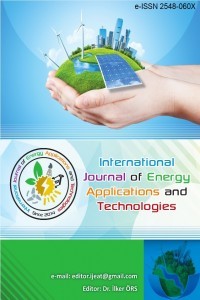Thermal efficiency evaluation of an organic Rankine cycle with n-pentane as working fluid
Thermal efficiency evaluation of an organic Rankine cycle with n-pentane as working fluid
In this study, the effect of evaporation pressure and superheating temperature on system performance was determined in the Organic Rankine Cycle (ORC) model designed using n-pentane fluid. EES (Engineering Equation Solver) software design using 9 different conditions have been identified. In the first model where the evaporation pressure was between 250 kPa and 400 kPa, the efficiency of ORC was determined under five different constant superheating temperatures. In the second model, the evaporation pressure was determined as 4 different constant values and the temperature of the superheating temperature was changed between 0 oC and 20 oC. N-pentane, which is widely used in ORC geothermal applications, has been determined as working fluid. Within the scope of geothermal applications, the heat source temperature is assumed to be constant at 120 °C. Condenser pinch point temperature difference is taken as 3 oC. As a result of the study, the data obtained from two different models were evaluated separately. When the superheating temperature is not applied, turbine work increases by 35% as the evaporation pressure rises from 250 kPa to 400 kPa. In addition, thermal efficiency also increased by 26%. When the evaporation pressure is constant at 250 kPa, the turbine work increased by 7.32% due to the increase of the superheating temperature from 0 oC to 20 oC. However, with the increase of heat input, thermal efficiency decreased by 1.38%. In the ORC system using N-pentane, it is stated that application of the superheating temperature reduces the performance. In the study, the highest thermal efficiency (12.59%) was achieved at the evaporation pressure of 400 kPa in the case of not applying superheating. The main purpose of this study was to evaluate the thermal efficiency of n-pentane fluid used in the geothermal applications of ORC under different evaporation pressure and overheating temperatures.
___
- [1] Ağırkaya, O., 2015, "Jeotermal Enerji Kaynaklı Organik Rankine Çevriminin Modellenmesi ve Analizi", Master Thesis, İstanbul Teknik University, Graduate School of Natural Sciences, İstanbul, Turkey.
- [2] Kaska, O., 2014, “Energy and exergy analysis of an organic Rankine for power generation from waste heat recovery in steel industry”, Energy Conversion and Management, 77, 108-117.
- [3] Lecompte, S., Ameel, B., Ziviani, D., Broek, M., Paepe, M., 2014, “Exergy analysis of zeotropic mixtures as working fluids in Organic Rankine Cycles”, Energy Conversion and Management, 85, 727-739.
- [4] Le, V., Feidt, M., Kheiri, A., Pelloux-Prayer, S., 2014, “Performance optimization of low-temperature power generation by supercritical ORCs (organic Rankine cycles) using low GWP (global warming potential) working fluids”, Energy, 67, 513-526.
- [5] Javanshir, A., Sarunac, N., 2017, “Thermodynamic analysis of a simple Organic Rankine Cycle”, Energy, 118, 85-96.
- [6] Li, L., Ge, Y., Tassoua, S., 2017, “Experimental Study on a small-scale R245fa Organic Rankine cycle system for low-grade thermal Energy Recovery”, Energy Procedia, 105, 1827-1832.
- [7] Wang, H., Li, H., Wang, L., Bu, X., 2017, “Thermodynamic Analysis of Organic Rankine Cycle with Hydrofluoroethers as Working Fluids”, Energy Procedia, 105, 1889-1894.
- [8] Li, J., Liu, Q., Ge, Z., Duan, Y., Yang, Z., 2017, “Thermodynamic performance analyses and optimization of subcritical and transcritical organic Rankine cycles using R1234ze(E) for 100–200℃ heat sources”, Energy Conversion and Management, 149, 140-154.
- [9] Feng, Y.Q., et al., 2017, “Operation characteristic of a R123-based organic Rankine cycle depending on working fluid mass flow rates and heat source temperatures”, Energy Conversion and Management, 131, 55-68.
- [10] Li, G., 2016, “Organic Rankine cycle performance evaluation and thermoeconomic assessment with various applications partI: Energy and exergy performance evaluation”, Renewable and Sustainable Energy Reviews, 53, 477-499.
- [11] Calm J.M., Hourahan, G.C., 2007, “Refrigerant Data Update”, Heating/Piping/Air Conditioning Engineering, 79(1), 50-64.
- Yayın Aralığı: Yılda 2 Sayı
- Başlangıç: 2014
- Yayıncı: İlker ÖRS
Sayıdaki Diğer Makaleler
Induction assisted pasteurization of honey
Tuncay YILMAZ, Anıl BAŞARAN, Can ÇİVİ
Effects of biodiesel usage on mechatronic components in automobiles with diesel engine: A review
Thermal efficiency evaluation of an organic Rankine cycle with n-pentane as working fluid
Sadık ATA, Ali KAHRAMAN, Remzi ŞAHİN
Particle mass and gaseous emissions from small scale modern wood stoves
Effect of iridium spark plug gap on emission, noise, vibration of an internal combustion engine
